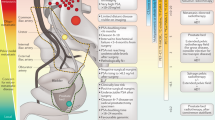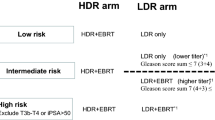Abstract
In patients presenting with clinically localized prostate cancer, the risk of biochemical failure increases significantly with higher Gleason scores, prostate specific antigen (PSA) levels, and clinical stages. Current surgical and radiotherapeutic approaches appear to offer limited success in patients with highly adverse prognostic factors. In an attempt to improve on these outcomes, we have combined external beam radiotherapy (EBRT) with a brachytherapy (BT) boost and neo adjuvant and adjuvant androgen ablation in a population at significant risk of biochemical failure. Here we present early biochemical progression data for this approach. From October 1997 to July 1999, 72 men with a serum PSA ≥10 ng/ml or Gleason score ≥7 or clinical stage ≥T2c (AJC/UICC 1992) underwent EBRT followed by palladium-103 BT. All patients underwent 8 months of combined androgen ablation with leuprolide and an oral antiandrogen beginning 3 months prior to initiation of EBRT. Patients were followed by PSA and digital rectal examination (DRE) at 3-month intervals and a chart review on all patients was carried out during July 2001. To allow comparisons to contemporary literature, Kaplan-Meier survival curves were generated utilizing three alternate definitions of biochemical recurrence: PSA >0.2 ng/ml, PSA >1.0 ng/ml, and the American Society for Therapeutic Radiology and Oncology (ASTRO) consensus definition of three consecutive rising PSAs. Our results indicate that when PSA >0.2 ng/ml was used to define biochemical progression, 88% (95% CI 80–97) of patients remained free of disease at 24 months. When PSA >1.0 ng/ml was used, 97% (CI 92–100) of patients remained disease free at 24 months. ASTRO criteria yielded 90% (CI 82–98) recurrence-free survival at 24 months. In conclusion, this very early report indicates that in patients who are at increased risk of biochemical failure, EBRT with a BT boost in conjunction with short-term androgen ablation offers potentially superior biochemical disease-free survival to contemporary alternative approaches in the literature. Clearly, longer follow-up is required to confirm the durability of this approach.
This is a preview of subscription content, access via your institution
Access options
Subscribe to this journal
Receive 4 print issues and online access
$259.00 per year
only $64.75 per issue
Buy this article
- Purchase on Springer Link
- Instant access to full article PDF
Prices may be subject to local taxes which are calculated during checkout


Similar content being viewed by others
References
Greenlee RT, Murray T, Bolden S, Wingo PA . Cancer statistics, 2000 CA Cancer J Clin 2000 50: 7–33
Walsh PC . Radical prostatectomy for localized prostate cancer provides durable cancer control with excellent quality of life: a structured debate. J Urol 2000 163: 1802–1807
Zelefsky MJ et al. Comparison of the 5-year outcome and morbidity of three-dimensional conformal radiotherapy versus transperineal permanent iodine-125 implantation for early-stage prostatic cancer J Clin Oncol 1999 17: 517–522
Critz FA et al. Simultaneous irradiation for prostate cancer: intermediate results with modern techniques J Urol 2000 164: 738–741
Koppie TM et al. The efficacy of cryosurgical ablation of prostate cancer: the University of California, San Francisco experience. J Urol 1999 162: 427–432
Catalona WJ, Smith DS . Cancer recurrence and survival rates after anatomic radical retropubic prostatectomy for prostate cancer: intermediate-term results J Urol 1998 160: 2428–2432
Gerber GS et al. Results of radical prostatectomy in men with clinically localized prostate cancer [see comments] JAMA 1996 276: 615–619
Cheng WS et al. Radical prostatectomy for pathologic stage C prostate cancer: influence of pathologic variables and adjuvant treatment on disease outcome Urology 1993 42: 283–291
Fair WR, Betancourt JE . Update on memorial sloan-kettering cancer center studies of neoadjuvant hormonal therapy for prostate cancer [In Process Citation] Mol Urol 2000 4: 241–248
Laverdiere J et al. Beneficial effect of combination hormonal therapy administered prior and following external beam radiation therapy in localized prostate cancer [see comments] Int J Radiat Oncol Biol Phys 1997 37: 247–252
Pilepich MV et al. Phase III trial of androgen suppression using goserelin in unfavorable-prognosis carcinoma of the prostate treated with definitive radiotherapy: report of Radiation Therapy Oncology Group Protocol 85-31 J Clin Oncol 1997 15: 1013–1021
Bolla M et al. Improved survival in patients with locally advanced prostate cancer treated with radiotherapy and goserelin [see comments] N Engl J Med 1997 337: 295–300
D'Amico AV et al. Biochemical outcome after radical prostatectomy, external beam radiation therapy, or interstitial radiation therapy for clinically localized prostate cancer [see comments] JAMA 1998 280: 969–974
Consensus statement: guidelines for PSA following radiation therapy. American Society for therapeutic Radiology and Oncology Consensus Panel [see comments] Int J Radiat Oncol Biol Phys 1997 37: 1035–1041
Partin AW et al. Combination of prostate-specific antigen, clinical stage, and Gleason score to predict pathological stage of localized prostate cancer. A multi-institutional update [see comments] [published erratum appears in JAMA 1997; 278: 118] JAMA 1997 277: 1445–1451
Ling CC . Permanent implants using Au-198, Pd-103 and I-125: radiobiological considerations based on the linear quadratic model Int J Radiat Oncol Biol Phys 1992 23: 81–87
Sobin LH, Wittekind C . TNM Classification of Malignant Tumors (5th edn) John Wiley & Sons: New York 1992
Krupski T, Petroni GR, Bissonette EA, Theodorescu D . Quality-of-life comparison of radical prostatectomy and interstitial brachytherapy in the treatment of clinically localized prostate cancer Urology 2000 55: 736–742
Sylvester J, Blasko JC, Grimm P, Ragde H . Interstitial implantation techniques in prostate cancer J Surg Oncol 1997 66: 65–75
Critz FA et al. Post-treatment PSA < or=0.2 ng/ml defines disease freedom after radiotherapy for prostate cancer using modern techniques Urology 1999 54: 968–971
Cavanagh W, Blasko JC, Grimm PD, Sylvester JE . Transient elevation of serum prostate-specific antigen following (125)I/(103)Pd brachytherapy for localized prostate cancer Semin Urol Oncol 2000 18: 160–165
Critz FA et al. Prostate specific antigen bounce after radioactive seed implantation followed by external beam radiation for prostate cancer J Urol 2000 163: 1085–1089
Ragde H, Korb LJ, Elgamal AA, Grado GL, Nadir BS . Modern prostate brachytherapy. Prostate specific antigen results in 219 patients with up to 12 y of observed follow-up Cancer 2000 89: 135–141
Potters L, Torre T, Ashley R, Leibel S . Examining the role of neoadjuvant androgen deprivation in patients undergoing prostate brachytherapy J Clin Oncol 2000 18: 1187–1192
Cha CM et al. Isotope selection for patients undergoing prostate brachytherapy [see comments] Int J Radiat Oncol Biol Phys 1999 45: 391–395
Acknowledgements
The authors wish to thank Drs Jay Y Gillenwater and Marguerite C Lippert for contributing patients to the study and Drs Bernard Schneider and Tyvin Rich for their assistance with the implant planning and procedure. This work was supported in part by Grant 97-64 from the Milhein Foundation
Author information
Authors and Affiliations
Corresponding author
Rights and permissions
About this article
Cite this article
Coblentz, T., Bissonette, E., Williams, K. et al. Multimodality radiotherapy and androgen ablation in the treatment of clinically localized prostate cancer: early results in high risk patients. Prostate Cancer Prostatic Dis 5, 219–225 (2002). https://doi.org/10.1038/sj.pcan.4500585
Received:
Revised:
Accepted:
Published:
Issue Date:
DOI: https://doi.org/10.1038/sj.pcan.4500585



